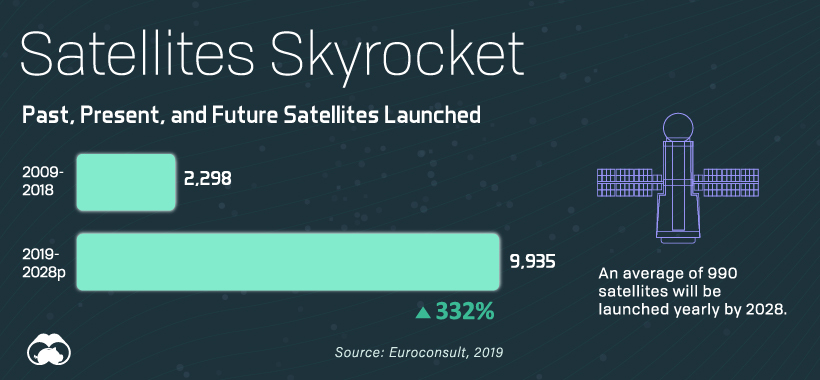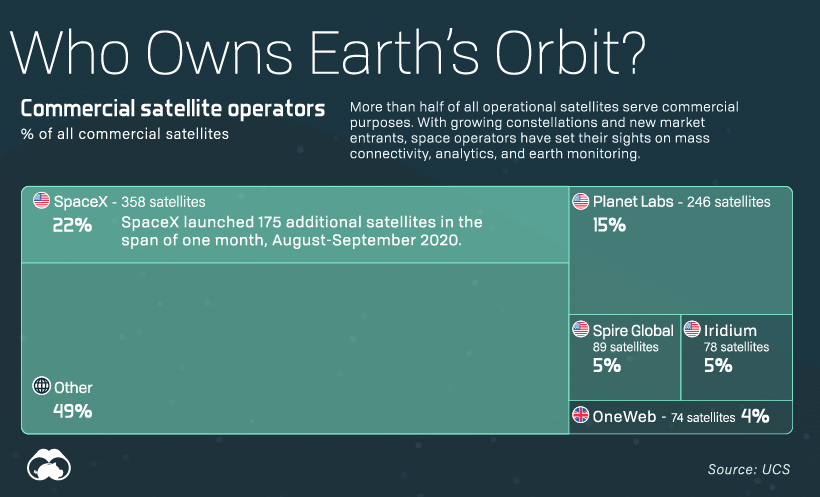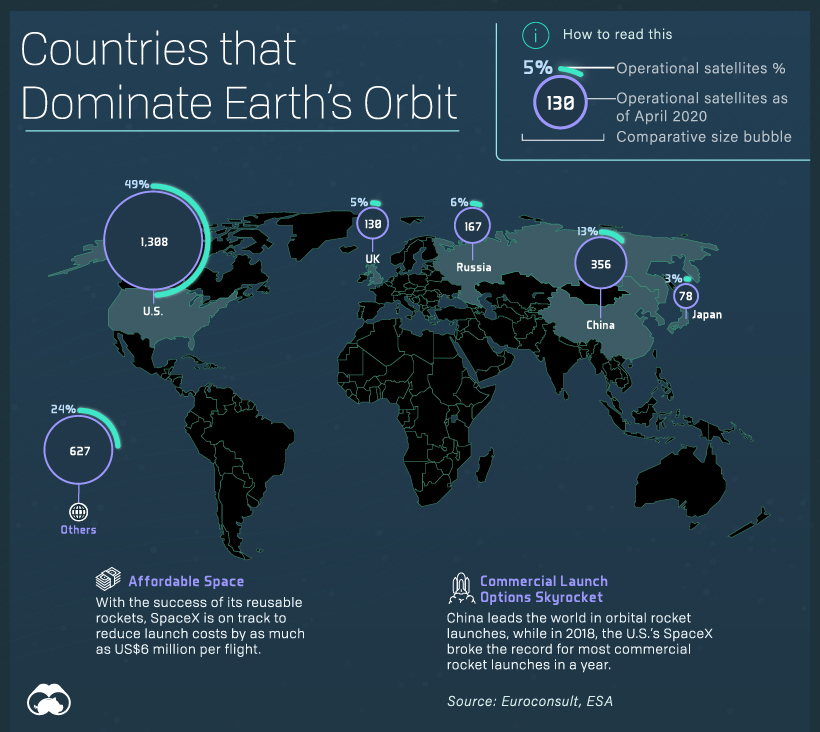Today, there are seemingly countless benefits and applications of space technology. Satellites, for instance, are becoming critical for everything from internet connectivity and precision agriculture, to border security and archaeological study.
Space is Open for Business
Right now, there are nearly 6,000 satellites circling our tiny planet. About 60% of those are defunct satellites—space junk—and roughly 40% are operational. As highlighted in the chart above, The Union of Concerned Scientists (UCS), determined that 2,666 operational satellites circled the globe in April of 2020. Over the coming decade, it’s estimated by Euroconsult that 990 satellites will be launched every year. This means that by 2028, there could be 15,000 satellites in orbit.
Let’s take a closer look at who operates those satellites and how they apply their technology.
Technology with a Purpose
Humans have long used space for navigation. While sailors once relied on the stars, today we use satellites for GPS, navigation, and various other applications. More than half of Earth’s operational satellites are launched for commercial purposes. About 61% of those provide communications, including everything from satellite TV and Internet of Things (IoT) connectivity to global internet. Second to communications, 27% of commercial satellites have been launched for Earth Observation (EO) purposes, including environmental monitoring and border security. Commercial satellites, however, can serve multiple purposes. One week, a satellite may be ‘tasked’ to image a contested border. It could later be tasked to monitor the reclamation of a mining site or even the aftermath of a natural disaster. Government and civil purposes make up 21% of all of Earth’s operational satellites, and military purposes come in at 13%.
Who Owns Earth’s Orbit? Space Operators
SpaceX—founded by Elon Musk—is not only a disruptive launch provider for missions to the International Space Station (saving NASA millions). It’s also the largest commercial operator of satellites on the planet. With 358 satellites launched as of April, part of SpaceX’s mission is to boost navigation capabilities and supply the world with space-based internet. While the company operated 22% of the world’s operational satellites as of April, it went on to launch an additional 175 satellites in the span of one month, from August to September 2020.
Following its series of summer launches, SpaceX announced that it had deployed enough satellites to support the beta version of its satellite-based internet service, Starlink.
Every Commercial Satellite in One Table
Since December 2005, the UCS has compiled data on every operational satellite in Earth’s orbit. In the table below, you’ll find every commercial satellite in orbit, as of April 2020. Cubesats, microsats, nanosats, and more—the new space race is all about small satellites. With its flock of small EO satellites, or “doves”, Planet Labs now has more than 150 satellites in operation (however, in April 2020, the number exceeded 250, as per above data).
Nations that Dominate Earth’s Orbit
It may be no surprise that the United States, China, and Russia top the list of countries with operational satellites. The U.S. and Russia (then the USSR) piloted the space race throughout the 1950s and 1960s. Both nations are found in the top three of current satellite operators, with the U.S. operating nearly half of all satellites—1,308 as of April 2020. China trails the U.S. with approximately 356 satellites. Taking third spot, Russia has 167 satellites in operation, and the UK comes in at a close fourth with 130 satellites.
Collectively, the above five countries operate roughly 76% of the world’s satellites.
The New Space Race
Where the original space race was a nationalistic competition between Cold War rivals, the new space race is collaborative and commercialized. Today, international cooperation allows for the deployment of satellites, as well as space-based science. Before SpaceX, NASA and the other space agencies that operate the International Space Station had been reliant on Russian Soyuz rockets for hundreds of missions. With the success of its famed reusable rockets, SpaceX is on track to reduce launch costs by as much as US$6 million per flight—which is likely to support the proliferation of satellites in the coming years. With improved technology and commercial partnerships, all signs point to a crowded orbit. Correction: In the table, Intelsat was listed as having 36 owned satellites in operation. The correct number is 51. on But fast forward to the end of last week, and SVB was shuttered by regulators after a panic-induced bank run. So, how exactly did this happen? We dig in below.
Road to a Bank Run
SVB and its customers generally thrived during the low interest rate era, but as rates rose, SVB found itself more exposed to risk than a typical bank. Even so, at the end of 2022, the bank’s balance sheet showed no cause for alarm.
As well, the bank was viewed positively in a number of places. Most Wall Street analyst ratings were overwhelmingly positive on the bank’s stock, and Forbes had just added the bank to its Financial All-Stars list. Outward signs of trouble emerged on Wednesday, March 8th, when SVB surprised investors with news that the bank needed to raise more than $2 billion to shore up its balance sheet. The reaction from prominent venture capitalists was not positive, with Coatue Management, Union Square Ventures, and Peter Thiel’s Founders Fund moving to limit exposure to the 40-year-old bank. The influence of these firms is believed to have added fuel to the fire, and a bank run ensued. Also influencing decision making was the fact that SVB had the highest percentage of uninsured domestic deposits of all big banks. These totaled nearly $152 billion, or about 97% of all deposits. By the end of the day, customers had tried to withdraw $42 billion in deposits.
What Triggered the SVB Collapse?
While the collapse of SVB took place over the course of 44 hours, its roots trace back to the early pandemic years. In 2021, U.S. venture capital-backed companies raised a record $330 billion—double the amount seen in 2020. At the time, interest rates were at rock-bottom levels to help buoy the economy. Matt Levine sums up the situation well: “When interest rates are low everywhere, a dollar in 20 years is about as good as a dollar today, so a startup whose business model is “we will lose money for a decade building artificial intelligence, and then rake in lots of money in the far future” sounds pretty good. When interest rates are higher, a dollar today is better than a dollar tomorrow, so investors want cash flows. When interest rates were low for a long time, and suddenly become high, all the money that was rushing to your customers is suddenly cut off.” Source: Pitchbook Why is this important? During this time, SVB received billions of dollars from these venture-backed clients. In one year alone, their deposits increased 100%. They took these funds and invested them in longer-term bonds. As a result, this created a dangerous trap as the company expected rates would remain low. During this time, SVB invested in bonds at the top of the market. As interest rates rose higher and bond prices declined, SVB started taking major losses on their long-term bond holdings.
Losses Fueling a Liquidity Crunch
When SVB reported its fourth quarter results in early 2023, Moody’s Investor Service, a credit rating agency took notice. In early March, it said that SVB was at high risk for a downgrade due to its significant unrealized losses. In response, SVB looked to sell $2 billion of its investments at a loss to help boost liquidity for its struggling balance sheet. Soon, more hedge funds and venture investors realized SVB could be on thin ice. Depositors withdrew funds in droves, spurring a liquidity squeeze and prompting California regulators and the FDIC to step in and shut down the bank.
What Happens Now?
While much of SVB’s activity was focused on the tech sector, the bank’s shocking collapse has rattled a financial sector that is already on edge.
The four biggest U.S. banks lost a combined $52 billion the day before the SVB collapse. On Friday, other banking stocks saw double-digit drops, including Signature Bank (-23%), First Republic (-15%), and Silvergate Capital (-11%).
Source: Morningstar Direct. *Represents March 9 data, trading halted on March 10.
When the dust settles, it’s hard to predict the ripple effects that will emerge from this dramatic event. For investors, the Secretary of the Treasury Janet Yellen announced confidence in the banking system remaining resilient, noting that regulators have the proper tools in response to the issue.
But others have seen trouble brewing as far back as 2020 (or earlier) when commercial banking assets were skyrocketing and banks were buying bonds when rates were low.
















